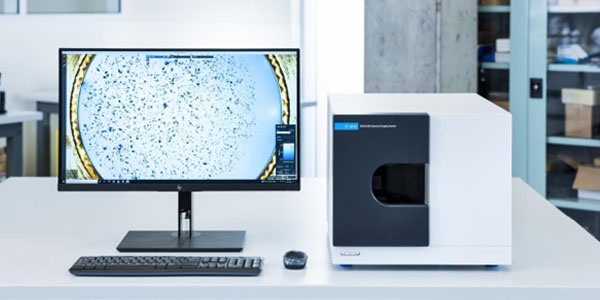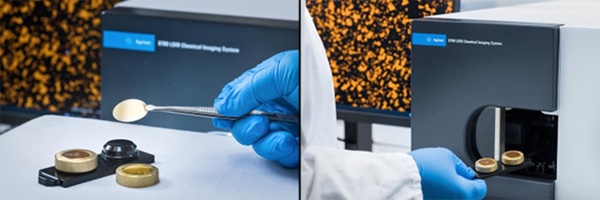
Chemical imaging has a new name: LDIR (Laser Direct Infrared Imaging)
I absolutely love infrared microscopy. Distinguishing between seemingly identical materials using light we cannot even see feels nothing short of a fantastic trick. This isn’t a trick at all though, and by doing away with binoculars, manually driven sample stages and steep learning curves, the 8700 LDIR Chemical Imaging System has shown the world it is truly the next evolution of infrared microscopy. Think of navigating using a voice-guided GPS system compared to paper maps of old, and you’re on the right track.
How does the 8700 LDIR Chemical Imaging System differentiate itself from other infrared microscopes?
The 8700 LDIR uses a tunable quantum cascading laser to shine incredible amounts of mid-infrared light onto very tiny spots of the sample. The laser performs a raster scan across the sample (or a user-defined sub-area) by moving back and forth at 80 Hz whilst the sample stage moves in a perpendicular direction. A chemical image is thus rapidly generated line by line in real time, and particle edges are easily discerned through contrast using image processing algorithms. Once the chemical image is complete and all particle boundaries are visible, the laser then acquires a full spectrum from the center of each particle in series, and identifies each based on comparisons with a reference library.
Watch this video to see how the 8700 LDIR Chemical Imaging System rapidly constructs a chemical image and identifies micron-sized particles.
Consequently the 8700 LDIR’s total sample analysis time is limited only by the number of particles found, rather than surface area chosen for analysis. Analysis of large areas is hence much quicker than competing technologies such as Focal Plane Array (FPA) FTIR microscopes and Raman microscopes. Topping this long list of advantages is a purpose-built LDIR filter holder to analyze particles directly on gold-coated filters used in vacuum filtration. No more particles lost due to rinsing and transferring onto slides!

All this is realized in fully automated fashion through the Clarity software, which offers a software graphical interface reminiscent of Google Maps in lieu of directly viewing samples through microscope binoculars. The entire sample surface is viewable at once, with easy controls to zoom into specific areas. In addition, a built-in high-magnification visible camera is available for discerning very small features down to single-digit microns in size.

The 8700 LDIR is redefining the microplastics analysis landscape
While much debate continues over what kind of damage microplastics impart on living beings, the general consensus is clear: microplastics are certainly not beneficial. The 8700 LDIR has gathered much attention since its release due to its ease-of-use, speed and accuracy of microplastic analysis, including effortlessly analyzing large sample areas. This novel technology recently received accreditation as a certified method of microplastic analysis from Eurofins, a global influencer in the field of microplastics analysis, in addition to publications by multiple key groups in the USA demonstrating full microplastic analysis workflows for the 8700 LDIR. Even machine learning is being applied to data from the 8700 LDIR in hopes of further improving identification of environmentally damaged microplastics.
The 8700 LDIR has demonstrated enormous potential for providing the most trusted answers in the field of microplastics analysis, and things can only get better from here. While the 8700 LDIR cannot reduce the terrifying amount of plastic waste itself, quickly and definitively identifying these microplastics can go a long way towards determining point of origin, thus providing the crucial data needed to start reducing said waste.
Further reading
- Technical overview: Analyzing microplastics
- Application note: Characterization of Microplastics in Environmental Samples by Laser Direct Infrared Imaging and User‑Generated Libraries
- Application note: Analyzing Colored Microplastics with the Agilent 8700 Laser Direct Infrared (LDIR) Chemical Imaging System
- Application note: Accurate Microplastic Characterization in Infant Formula
Molecular spectroscopy webinar series
Get the latest product information and lots of helpful tips and tricks from our frequent molecular spectroscopy webinars. These live and interactive sessions take place every week, with all previous sessions available to watch on-demand.
Got a question? Leave a note on the comments below or send your query directly to our expert spectroscopy team.

